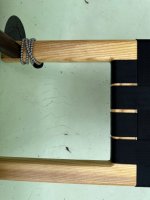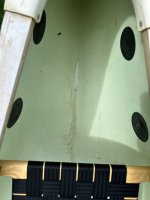I have a 70s era Royalex Tripper that I bought a couple years ago. It was mint, but certainly looked like it had been left out over the years: faded colors, gunwales, etc. The exterior vinyl layer seemed quite soft in comparison to newer Royalex. I paddled it empty many times that first year I owned it and then loaded it heavily and took it down the Machias River, in Maine, this past spring. Aside from scraping the heck out of the bottom on the bony Machias, it performed wonderfully and I did not notice any other deterioration. I haven't babied it and I've put it down perhaps a little more roughly than I should after a portage (when I've been tired) but it's Royalex, so I presumed no harm no foul.
However.... now I do see some harm in the form of the interior vinyl surface cracking along the edges of the bilge, where the hull turns upwards, and along the keel, at the extreme front and rear. The edges of the cracks are even turning up a little, as thought it could start to peel. There's no cracking of the exterior surface as far as I have noticed.
So, I'd like to seek the collective wisdom of the forum and ask: What's the diagnosis and prognosis? I had a custom spray cover made for this boat and I'm hoping to get many more years of use.
Thanks!




However.... now I do see some harm in the form of the interior vinyl surface cracking along the edges of the bilge, where the hull turns upwards, and along the keel, at the extreme front and rear. The edges of the cracks are even turning up a little, as thought it could start to peel. There's no cracking of the exterior surface as far as I have noticed.
So, I'd like to seek the collective wisdom of the forum and ask: What's the diagnosis and prognosis? I had a custom spray cover made for this boat and I'm hoping to get many more years of use.
Thanks!




Last edited:
